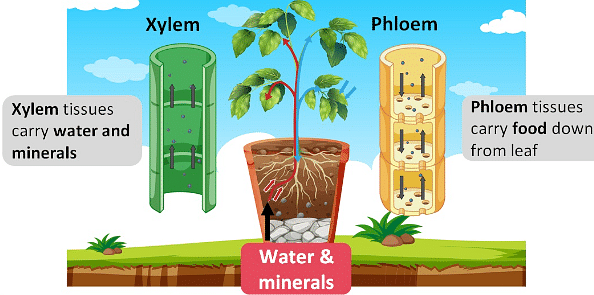Transportation
- Plants obtain energy through the process of photosynthesis, using carbon dioxide (CO2) and chlorophyll in their leaves.
- Plants also need other raw materials like nitrogen, phosphorus, and minerals to build their bodies, and they get these from the soil through their roots.
- When the distance between the roots and leaves is small, energy and raw materials can easily diffuse to all parts of the plant. But if the distance is large due to changes in plant design, diffusion alone is not enough, and a proper transportation system is needed.
- Since plants do not move and have a large proportion of dead cells in many tissues, their energy needs are relatively low. Therefore, they can use slower transport systems.
- In some plants, such as tall trees, the distances that need to be covered by the transport systems can be very large.
- Plant transport systems consist of two independently organized conducting tubes: xylem and phloem.
- Xylem is responsible for transporting water and minerals from the soil to all parts of the plant.
- Phloem transports the products of photosynthesis, such as sugars, from the leaves where they are made to other parts of the plant.
- The structures of xylem and phloem tissues have been studied in detail in Class IX (previous class).
- Water is transported in plants through a specialized tissue called xylem. The vessels and tracheids in the roots, stems, and leaves are interconnected, forming a continuous system of water-conducting channels throughout the plant.
- At the roots, cells in contact with the soil actively take up ions, creating a difference in ion concentration between the root and the soil. To eliminate this difference, water moves from the soil into the roots.
- As water enters the root xylem, a column of water is formed, and it is steadily pushed upwards. However, this pressure alone is not sufficient to move water to great heights in plants.
- Plants have another strategy to move water upward in the xylem. When water is lost through tiny openings called stomata on the leaves, it creates a suction that pulls water from the root xylem cells.
- The loss of water in the form of vapor from the aerial parts of the plant is known as transpiration.
- Transpiration plays a crucial role in the absorption and upward movement of water and minerals dissolved in it from the roots to the leaves. It also helps regulate temperature in plants.
- During the day, when the stomata are open, the transpiration pull becomes the major driving force in the movement of water in the xylem.
- The supply of water lost through transpiration is replenished by water from the xylem vessels in the leaf.
.png)



